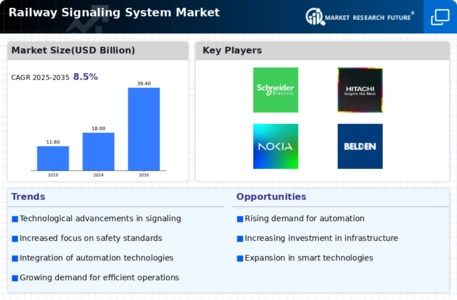Leading market players are investing heavily in the research and development in order to expand their product lines, which will help the Railway Signaling System market grow even more. Market players are also undertaking a variety of strategic activities to spread their global footprint, with important market developments including mergers and acquisitions, new product launches, contractual agreements, higher investments, and collaboration with other organizations. To spread and survive in a more competitive and rising market climate, the Railway Signaling System industry must offer cost-effective items.
Manufacturing locally to minimize the operational costs is one of the key business tactics used by the manufacturers in the global Railway Signaling System industry to benefit the clients and increase the market sector. In recent years, the Railway Signaling System industry has offered some of the most significant advantages to the railway industry.
Major players in the Railway Signaling System market, including Schneider Electric, Hitachi Rail Ltd., Huawei Technologies Co Ltd., Cisco System Inc., Angelo Holdings SRL, Alstom, Siemens Mobility, Webtec Corporation, Nokia, Belden Inc., and others, are trying to increase market demand by investing in the research and development operations.
Alstom is a leading multinational company specializing in the design, manufacturing, and servicing of railway equipment and systems, as well as in the development of sustainable mobility solutions. The company has been at the forefront of innovation in rail transport, offering a comprehensive range of products and services, including high-speed trains, signaling systems, and integrated mobility solutions. Alstom is renowned for its commitment to sustainability, demonstrated through its development of eco-friendly technologies and solutions that contribute to the advancement of efficient and environmentally conscious transportation.
The company play an important role in shaping the future of rail travel and urban mobility, aligning with the global push toward more sustainable and interconnected transportation systems. In 2021, Alstom and Bombardier Transportation announced a partnership to develop and deploy a next-generation train control and management system (TCMS). The partnership will combine Alstom's expertise in signaling systems with Bombardier's expertise in train control systems.
Schneider Electric is the multinational corporation specializing in energy management and industrial automation. Headquartered in Rueil-Malmaison, France, the company operates globally and is a prominent player in the digital transformation of energy management and automation. With a history dating back to the 19th century, Schneider Electric has evolved into a leading provider of innovative solutions for residential, commercial, industrial, and infrastructure sectors. The company offers a broader range of products and services, including energy-efficient solutions, automation technologies, and digital solutions for homes, buildings, data centers, infrastructure, and industries.
Schneider Electric is committed to sustainability, evidenced by its efforts to promote the energy efficiency and renewable energy adoption. In 2022, Schneider Electric and Hitachi Rail announced a partnership to develop and deploy an integrated railway signaling and energy management system. The partnership will combine Schneider Electric's expertise in energy management with Hitachi Rail's expertise in signaling systems.





